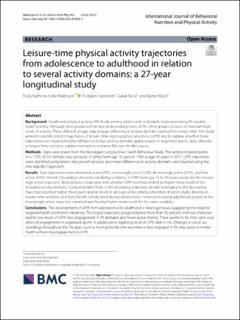| dc.description.abstract | Background Insufficient physical activity (PA) levels among adolescents and adults make promoting PA a public health priority. Although most people exhibit low or decreasing levels of PA, other groups increase or maintain high levels of activity. These different groups may engage differently in activity domains during their leisure time. This study aimed to identify distinct trajectories of leisure-time vigorous physical activity (LVPA) and to explore whether these trajectories are characterised by differences in four activity domains (participation in organised sports clubs, diversity in leisure-time activities, outdoor recreation, and peer PA) over the life course. Methods Data were drawn from the Norwegian Longitudinal Health Behaviour Study. The sample of participants (n = 1103, 45.5% female) was surveyed 10 times from age 13 years in 1990 to age 40 years in 2017. LVPA trajectories were identified using latent class growth analysis, and mean differences in activity domains were studied using the one-step BCH approach. Results Four trajectories were identified: active (9%), increasingly active (12%), decreasingly active (25%), and low active (54%). Overall, this analysis showed a declining tendency in LVPA from age 13 to 40 years except for the increasingly active trajectory. Belonging to a trajectory with a higher LVPA level was related to higher mean levels of the included activity domains. Compared with those in the increasing trajectory, people belonging to the decreasing trajectory reported higher mean participation levels in and age at becoming a member of sports clubs, diversity in leisure-time activities, and best friend’s activity level during adolescence. However, in young adulthood, people in the increasingly active trajectory reported significantly higher mean levels for the same variables. Conclusions The development of LVPA from adolescence to adulthood is heterogeneous, suggesting the need for targeted health promotion initiatives. The largest trajectory group included more than 50 percent and was characterized by low levels of LVPA, less engagement in PA domains and fewer active friends. There seems to be little carry-over effect of engagement in organised sports in adolescence regarding level of LVPA later in life. Changes in social surroundings throughout the life span, such as having friends who are more or less engaged in PA, may assist or hinder health enhancing engagement in LVPA. | en_US |

